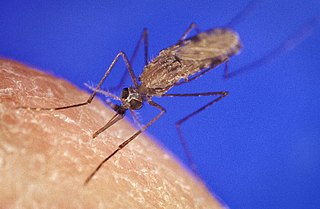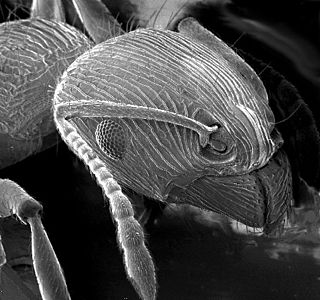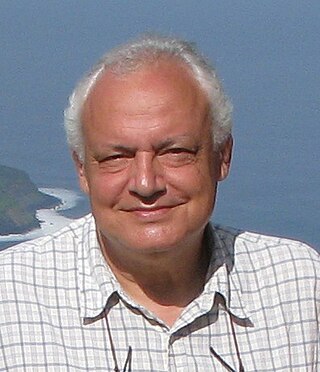Related Research Articles

Anopheles is a genus of mosquito first described by the German entomologist J. W. Meigen in 1818, and are known as nail mosquitoes and marsh mosquitoes. Many such mosquitoes are vectors of the parasite Plasmodium, a genus of protozoans that cause malaria in birds, reptiles, and mammals, including humans. The Anopheles gambiae mosquito is the best-known species of marsh mosquito that transmits the Plasmodium falciparum, which is a malarial parasite deadly to human beings; no other mosquito genus is a vector of human malaria.

Fotis Constantine Kafatos was a Greek biologist. Between 2007-2010 he was the founding president of the European Research Council (ERC). He chaired the ERC Scientific Council from 2006-2010. Thereafter, he was appointed Honorary President of the ERC.

Plasmodium berghei is a single-celled parasite causing rodent malaria. It is in the Plasmodium subgenus Vinckeia.

The Anopheles gambiae complex consists of at least seven morphologically indistinguishable species of mosquitoes in the genus Anopheles. The complex was recognised in the 1960s and includes the most important vectors of malaria in sub-Saharan Africa, particularly of the most dangerous malaria parasite, Plasmodium falciparum. It is one of the most efficient malaria vectors known. The An. gambiae mosquito additionally transmits Wuchereria bancrofti which causes lymphatic filariasis, a symptom of which is elephantiasis.
Odorant-binding proteins (OBPs) are small soluble proteins secreted by auxiliary cells surrounding olfactory receptor neurons, including the nasal mucus of many vertebrate species and in the sensillar lymph of chemosensory sensilla of insects. OBPs are characterized by a specific protein domain that comprises six α-helices joined by three disulfide bonds. Although the function of the OBPs as a whole is not well established, it is believed that they act as odorant transporters, delivering the odorant molecules to olfactory receptors in the cell membrane of sensory neurons.
Chemosensory proteins (CSPs) are small soluble proteins which mediate olfactory recognition at the periphery of sensory receptors in insects, similarly to odorant-binding proteins. The typical structure of CSPs is made of six or seven α-helical chains of about 110-120 amino acids, including four cysteines that build two small loops, two adjacent disulfide bridges, and a globular "prism-like" functional structure [5]. Three CSP structures have been solved in moths and locusts [5-8].

PITSLRE serine/threonine-protein kinase CDC2L1 is an enzyme that in humans is encoded by the CDK11B gene.

60S ribosomal protein L35 is a protein that in humans is encoded by the RPL35 gene.
Bursicon is an insect hormone which mediates tanning in the cuticle of adult flies. This hormone was identified by Gottfried S. Fraenkel with his student Catherine Hsiao in 1965.

Arthropods are covered with a tough, resilient integument, cuticle or exoskeleton of chitin. Generally the exoskeleton will have thickened areas in which the chitin is reinforced or stiffened by materials such as minerals or hardened proteins. This happens in parts of the body where there is a need for rigidity or elasticity. Typically the mineral crystals, mainly calcium carbonate, are deposited among the chitin and protein molecules in a process called biomineralization. The crystals and fibres interpenetrate and reinforce each other, the minerals supplying the hardness and resistance to compression, while the chitin supplies the tensile strength. Biomineralization occurs mainly in crustaceans. In insects and arachnids, the main reinforcing materials are various proteins hardened by linking the fibres in processes called sclerotisation and the hardened proteins are called sclerotin. The dorsal tergum, ventral sternum, and the lateral pleura form the hardened plates or sclerites of a typical body segment.

A genetically modified (GM) insect is an insect that has been genetically modified, either through mutagenesis, or more precise processes of transgenesis, or cisgenesis. Motivations for using GM insects include biological research purposes and genetic pest management. Genetic pest management capitalizes on recent advances in biotechnology and the growing repertoire of sequenced genomes in order to control pest populations, including insects. Insect genomes can be found in genetic databases such as NCBI, and databases more specific to insects such as FlyBase, VectorBase, and BeetleBase. There is an ongoing initiative started in 2011 to sequence the genomes of 5,000 insects and other arthropods called the i5k. Some Lepidoptera have been genetically modified in nature by the wasp bracovirus.

OrthoDB presents a catalog of orthologous protein-coding genes across vertebrates, arthropods, fungi, plants, and bacteria. Orthology refers to the last common ancestor of the species under consideration, and thus OrthoDB explicitly delineates orthologs at each major radiation along the species phylogeny. The database of orthologs presents available protein descriptors, together with Gene Ontology and InterPro attributes, which serve to provide general descriptive annotations of the orthologous groups, and facilitate comprehensive orthology database querying. OrthoDB also provides computed evolutionary traits of orthologs, such as gene duplicability and loss profiles, divergence rates, sibling groups, and gene intron-exon architectures.
John R. Carlson is an American biologist and professor. He currently holds the Eugene Higgins Professor of Molecular, Cellular, and Developmental Biology at Yale University. He is an elected member of the National Academy of Sciences.
Sir James William Longman Beament was a British scientist who studied insect physiology and psychoacoustics. He has been described as "an international authority" on "the structure and waterproofing of insect eggs".

Janet Hemingway is a British infectious diseases specialist. She is the former director of the Liverpool School of Tropical Medicine (LSTM) and founding director of the Infection Innovation Consortium and Professor of Tropical Medicine at LSTM. She is currently the president of the Royal Society of Tropical Medicine and Hygiene.
Thioester containing protein 1, often called TEP1 is a key component of the arthropod innate immune system. TEP1 was first identified as a key immunity gene in 2001 through functional studies on Anopheles gambiae mosquitoes.

Christos Louis, nicknamed Kitsos, is a Greek Molecular Geneticist. He graduated from the Medical School of the University of Marburg in 1974 and joined the team of Prof. C.E. Sekeris, first at Marburg and then at the German Cancer Research Center Heidelberg, obtaining his doctoral degree in Cell biology from Heidelberg University in 1977. His work focuses on Genomics and Bioinformatics of insects and vector-borne/tropical diseases.

Insect olfaction refers to the function of chemical receptors that enable insects to detect and identify volatile compounds for foraging, predator avoidance, finding mating partners and locating oviposition habitats. Thus, it is the most important sensation for insects. Most important insect behaviors must be timed perfectly which is dependent on what they smell and when they smell it. For example, olfaction is essential for locating host plants and hunting prey in many species of insects, such as the moth Deilephila elpenor and the wasp Polybia sericea, respectively.
Nora J. Besansky is an American molecular biologist. She is the Martin J. Gillen Professor of Biological Sciences at the University of Notre Dame. In 2020, Besansky was elected a Member of the National Academy of Sciences for being an expert in the genomics of malaria vectors.
Abdoulaye Diabaté is an African parasitologist, Professor and Head of the Medical Entomology and Parasitology Department at the Health Sciences Research Institute. His research considers the use of gene drive to eliminate malaria, and he leads Target Malaria Burkina Faso. He delivered the first genetically modified mosquitoes in Africa, marking a historic moment for science. He was awarded the 2023 Falling Walls Science Prize for Science and Innovation Management. In April 2024, he spoke at the TED 2024: The Brave and The Brilliant conference in Vancouver.
References
- 1 2 3 4 5 https://www.entsoc.org/fellows/judith-h-willis-esa-fellow-2004
- ↑ "Entomological society of America".
- ↑ "University of Georgia Office of Research".
- ↑ "Judith H. Willis". uga.edu. Retrieved April 26, 2017.